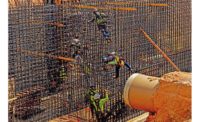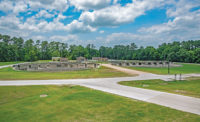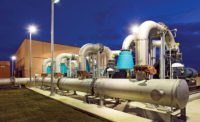Team Overcomes Hurdles on Texas Wastewater Treatment Plant Project
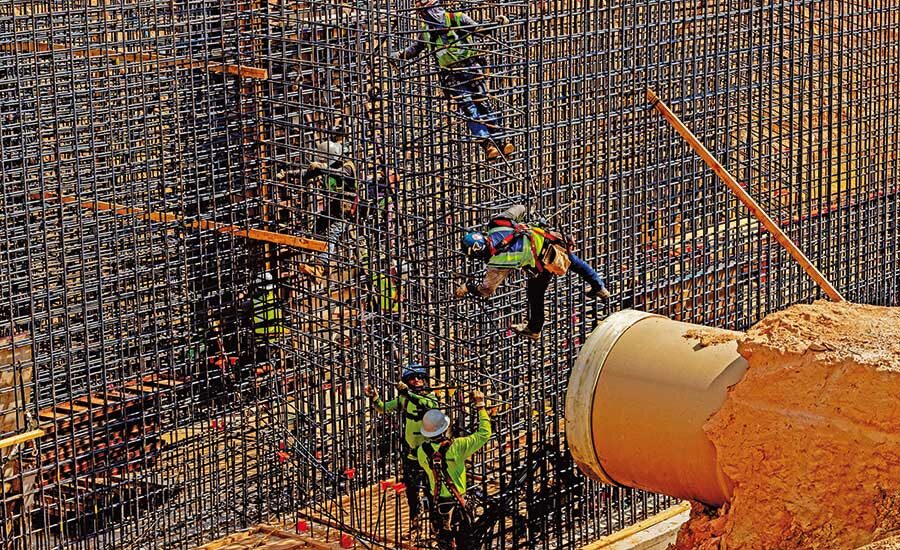
Steel workers tying aeration basin rebar at Conroe’s new Central Wastewater Treatment Plant.
PHOTO COURTESY OF LOCKWOOD, ANDREWS & NEWNAM INC.
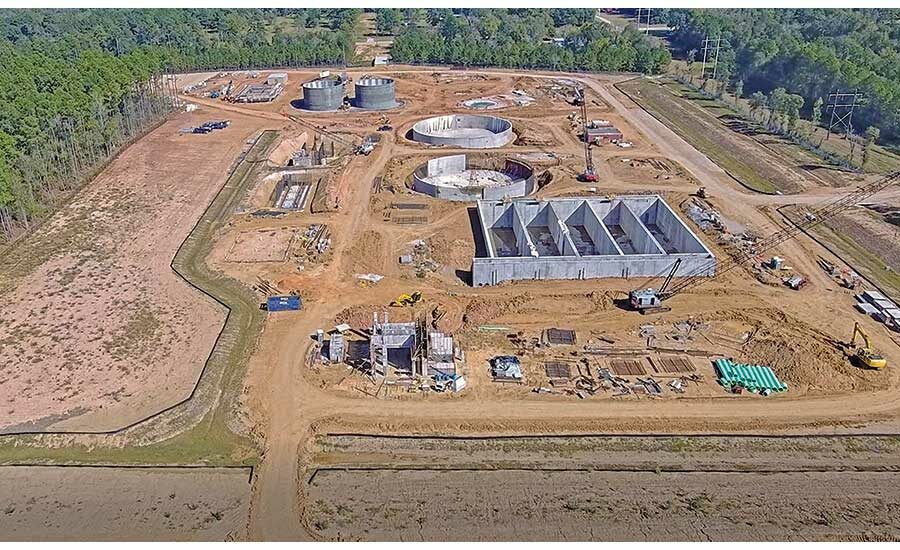
Aerial view of Conroe Central Wastewater Treatment Plant.
PHOTO COURTESY OF LOCKWOOD, ANDREWS & NEWNAM INC.
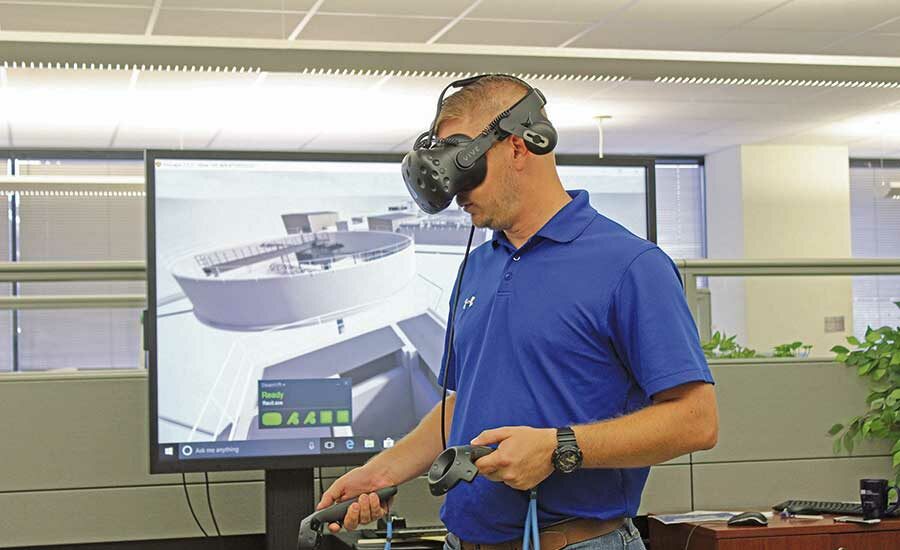
Greg Hall, superintendent of Conroe’s wastewater treatment plant, uses a VR headset to walk through the plant during the 75% design review.
PHOTO COURTESY OF LOCKWOOD, ANDREWS & NEWNAM INC.
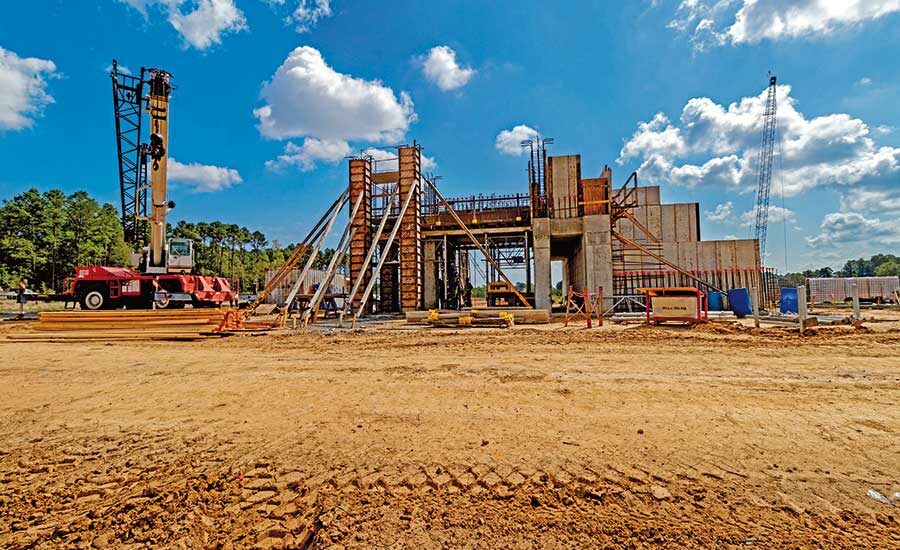
Construction progresses on the Conroe Central WWTP’s headworks.
PHOTO COURTESY OF LOCKWOOD, ANDREWS & NEWNAM INC.




Conroe, Texas, has been one of the 15 fastest-growing cities in the U.S. over the last 10 years, according to the U.S. Census Bureau. To keep pace, the city is building the $60-million Central Wastewater Treatment Plant (WWTP) with an initial capacity of 6 million gallons per day, expandable to 12 MGD. However, this effort encountered numerous obstacles, including a late-term design site change that triggered a series of budgetary and logistical hurdles.
The initial phase of this venture, which is the largest single public-works project in the city’s history, will provide additional treatment plant capacity to satisfy current demands while the expansion will address future needs, explains William Schlafer, senior project manager with project designer Lockwood, Andrews & Newnam Inc. (LAN).
“There is significant residential and commercial/industrial expansion in the Conroe area. Consequently, there is projected to be a substantial increase in wastewater treatment plant flows and demand in the very near future,” he adds.
When the facility comes online in spring 2022, it will increase the city of Conroe’s treatment capacity by 50%. It will be the first plant in the city to use ultraviolet disinfection, which will allow the facility to avoid the risks associated with chlorine gas disinfection.
LAN designed a master plan for Conroe’s wastewater treatment plant back in 2010, and subsequently designed improvements to Conroe’s existing Southwest Regional Wastewater Treatment Plant, Schlafer says. However, when the project was completed in 2016, that plant’s capacity was already approaching 75% capacity—and the Texas Commission on Environmental Quality requires that a new plant must be under design once an existing plant reaches 75% threshold capacity, he says.
As a result, in 2013 the city tasked LAN with designing the next phase of the master plan, the WWTP. Locally based general contractor LEM Construction Co. has the $60-million construction contract for the design-bid-build project.
“What was slightly different for this project was it was bid utilizing a competitive sealed proposal process. This allowed the client to select the best-value contractor based on qualifications as opposed to just the cheapest or lowest bid,” Schlafer explains.
LEM’s team began construction in December 2019. “We have hired many workers in the Conroe area, which bodes well for the community,” says Micah Allison, project manager with LEM. Many of these workers will remain LEM employees after the WWTP is complete.
During initial planning stages, LAN’s team met with local contractors to discuss ways in which construction could be made easier and more cost-effective, says Melissa Mack, LAN vice president.
“Suggestions included partially submerging the basins, trying to build at grade as much as possible, removing tops and specials, and not doing a lot of step changes in basin bottoms,” she says. “The value engineering that LAN facilitated at bid time saved more than $4 million.”
Moving Woes
After the design phase passed around 75%, the project team had to relocate the entire project.
“The city had purchased a plot of land that was in a flood zone. The outfall from that location created permitting issues,” explains Schlafer. “Initially, TCEQ approved the site, but later took away the discharge permit. Additionally, the U.S. Army Corps of Engineers also had issues with wetland permitting in that site.”
Thankfully, during the wastewater treatment master-planning process, LAN had identified three potential locations for the WWTP, and one—a 12-acre site—was chosen for the new facility. But that site change resulted in delays, which in turn led to increased costs, Schlafer says. The revised designs put estimated construction costs above the city’s budget, he adds.
A second value engineering process followed. One of the ways the team was able to cut costs was changing the plant’s treatment process.
When considering the city of Conroe’s needs, the treatment plant was originally conceived as a carbon diversion project as LAN incorporated an advanced treatment process into the facility design, says Paul Wood, senior associate at LAN.
“The advanced treatment design, a two-stage process known as the A/B process, would allow for anaerobic digestion of the two separate sludges produced,” he explains, noting that anaerobic digestion is typically not used in the Houston area. “With energy cheap in the 1970s, aerobic digestion was cheaper, and a great majority of these plants were constructed during this time and it became the default sludge treatment method.”
But anaerobic digestion offers key benefits over aerobic digestion, he explains. “First, the lack of aeration produces energy savings over aerobic digestion. Second, the biogas produced by anaerobic digestion can be captured, cleaned and utilized for power generation,” Wood says.
Postponing the carbon diversion process that used anaerobic digestion and changing the WWTP over to the more conventional aerobic digestion brought the project back within the city’s budget, Schlafer says.
But in order to allow the possibility of using anaerobic digestion in the future, “the design alterations were made in such a way that treatment elements could easily be transitioned back to the original design. This provided the owner the option to expand the treatment plant in the future without abandoning structures installed in the initial construction,” Wood says.
Finding an acceptable discharge location for the new site created additional permitting challenges, Wood says. “Most streams in the state are evaluated by the TCEQ for load carrying capacity. However, the selected discharge location for the new plant, Stewart Creek, wasn’t in TCEQ’s modeled system,” he says.
So the team turned to LAN’s in-house modeling expert Yu-Chun Su, who modeled the discharge into Stewart Creek. This model was sent to TCEQ, which helped expedite the permitting process as it was modified through a series of meetings to meet TCEQ requirements.
Another obstacle was the 20-ft elevation change from the east to west side of the new site.
“Also, there was a natural drainage channel that cut right through the middle of the project carrying offsite flow. As a result, drainage was a concern. Furthermore, the project began construction during December in the middle of the rainy season, which exacerbated these concerns,” Schlafer says.
At the project outset, LEM’s team performed all earthwork and excavation, moving more than 100,000 cu yd of material. The on-site storm drainage system, including swales and grading, was built immediately after the site was cleared and has been maintained throughout construction, Schlafer says. Meanwhile, “the offsite storm drainage, which originally naturally flowed across the WWTP site, was redirected around the site via swales and discharges into a creek adjacent to the site. This combination drainage system has been key to avoiding weather construction delays,” he says.
Because the new and existing wastewater treatment plants in Conroe will share an existing trunk sanitary sewer, the project team also needed to determine the best way to split this flow between both plants.
“A portion of it will be diverted to the new WWTP while the rest will continue downstream to the existing Southwest Regional Wastewater Treatment Plant. Originally, both plants were very close to the end of the trunk sewer, and it would have been easy to put in a splitter box and direct the wastewater flows to both plants,” Wood explains.
However, the new location created a more complicated flow split because it’s further upstream and on the other side of the freeway from the existing plant. That combined with the elevation change added to complications in splitting the flow, Wood explains.
To solve this, the project team designed a 16-ft by 12.5-ft diversion structure, where the flow rate can be monitored and adjusted as needed. “This is a passive structure, and diversion to the Conroe Southwest Regional Wastewater Treatment Plant is determined by how much flow the Conroe Central plant takes. The idea is to base-load the Conroe Central Plant at a constant rate,” Wood says.
Pandemic Impacts
On a project of this size, one superintendent would typically oversee multiple crews, but because of COVID-19, the project has four superintendents, each overseeing multiple crews, with about 100 workers on site most of the time, Wood says.
The pandemic also impacted the project’s supply of color-coded PVC pipe. Typically projects use blue pipe for clean water and green pipe for dirty water, Schlafer says.
“This project required a lot of green pipe. Unfortunately, due to manufacturing issues related to COVID-19 and reduced demand in the oil industry, the manufacturer indicated that the green pipe wasn’t going to be made for another 12 months,” he says. So LEM’s team, with permission from the city, instead wrapped blue pipe with green plastic for clear identification.
At one point, LEM had to shut down all construction for about two weeks after as many as 26 workers tested positive for the virus. But the contractor remained proactive, paying for expedited testing any time a worker showed symptoms, with results within 24 hours.
“Despite the two-week shutdown, the critical nature of the project meant that construction had to continue. The contractor’s crews worked efficiently and kept the project moving forward. Despite a few COVID-19 flare-ups, the contractor has proactively minimized its spread between crews and used very efficient construction practices,” Wood says.
Construction is halfway complete, and contractor LEM is tracking about 50 days ahead of schedule. Over the 92,645 worker hours completed so far, the team has had zero lost-time or recordable incidents, Allison says.
Safety measures included the use of stanchions and safety cables that “gave employees the freedom to move yet remain safely tied off 24 feet in the air,” Allison says. “At the headworks, we efficiently left the shoring and handrail up the entire time to build the bar screen channels, creating a safe working platform for the duration of that work. We also devised a series of platforms mounted to the inside of the lift station wet well to gain safe access there down to 38-feet deep.”
The city of Conroe will be hiring four operators, a pump mechanic, a maintenance tech, a truck driver and a press operator for the new facility, says Christopher Bogert, the city’s engineering manager. “We anticipate that we will be providing approximately four loads a day of sludge to the local business that converts it to private use,” he says.
Completion of Conroe’s WWTP is expected in spring 2022.


